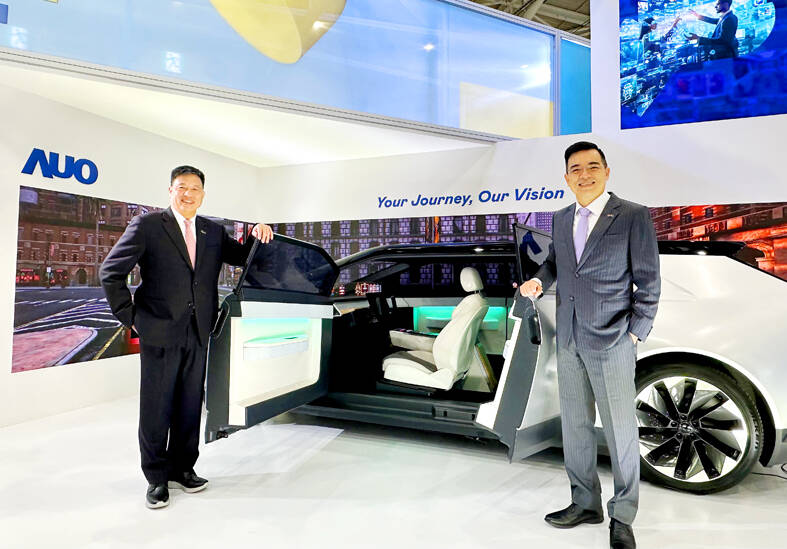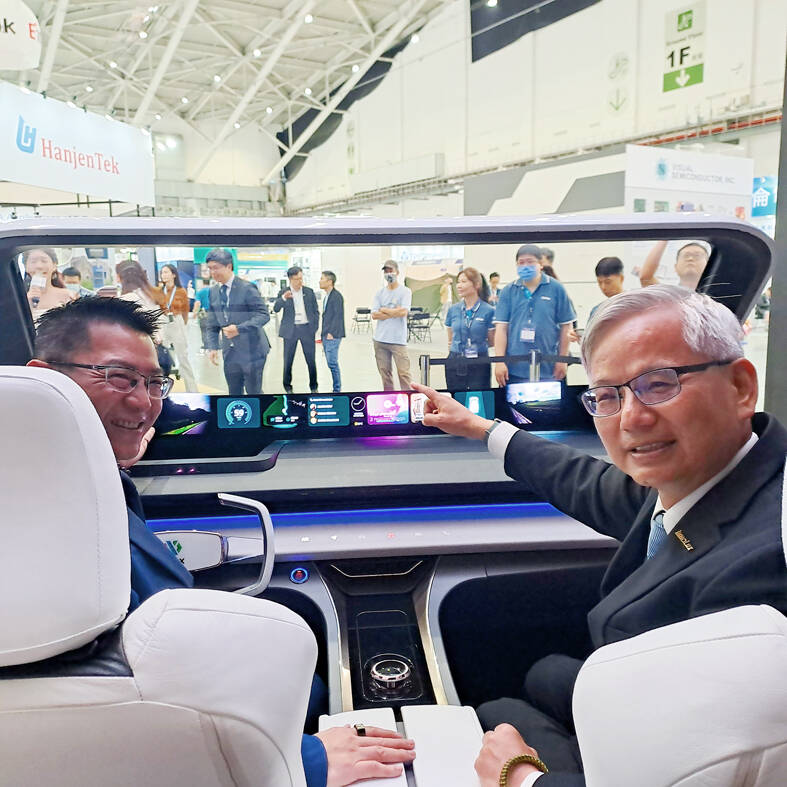Flat-panel display makers AUO Corp (友達) and Innolux Corp (群創) yesterday said that about 12 to 20 percent of their display business is at risk of potential US tariffs and that they would relocate production or shipment destinations to mitigate the levies’ effects.
US tariffs would have a direct impact of US$200 million on AUO’s revenue, company chairman Paul Peng (彭雙浪) told reporters on the sidelines of the Touch Taiwan trade show in Taipei yesterday.
That would make up about 12 percent of the company’s overall revenue.

Photo: Ann Wang, Reuters
To cope with the tariff uncertainty, AUO plans to allocate its production to manufacturing facilities in countries subject to lower US “reciprocal” tariffs, leveraging its global manufacturing footprint, Peng said.
The company has added new manufacturing sites in India, Europe and Mexico following the acquisition of BHTC GmbH, a German cockpit operation system supplier, he said.
The company would not consider building a front-end display manufacturing facility in the US, due to expensive labor costs and the lack of a comprehensive display supply chain in the country, he said.

Photo: Chen Mei-ying, Taipei Times
Innolux also said it had no plans to build a manufacturing site in the US.
As a major vehicle and TV display supplier to tier-one customers, Innolux has a bigger US exposure than other display and component suppliers, chief executive officer Jim Hung (洪進揚) told a news conference in Taipei.
The company ships vehicle displays directly to customers in the US and Europe, with direct exposures of up to 8 to 10 percent, and as TV brands are among its tier-one customers, it has to directly ship TV displays to the US, Hung said.

Photo: CNA
Indirect exposures to the US accounted for about 10 to 15 percent, he said.
Like most component suppliers, Innolux also ships its displays to electronic assemblers’ factories in China, Vietnam, Thailand and other regions, he said.
In the face of rising uncertainty, Innolux has activated a stringent supply chain management mechanism as it did during the COVID-19 pandemic, Hung said.
The aim is to ensure an optimal level of component inventory as customers are scrambling to stock up on as many goods as possible at their hubs during the 90-day tariff pause announced last week by US President Donald Trump, he said.
With the lasting tariff challenges and geopolitical risks, Innolux would be more “selective in terms of manufacturing sites and partners,” compared with its strategies during the pandemic, he said.
The company is considering shifting more TV panels to TV makers in Mexico from China, given that Mexico is subject to a significantly lower US import duty than China, he said.
AUO and Innolux reported new rush orders this quarter as customers strive to avoid US tariffs.
Hung said second-quarter revenue would outgrow Innolux’s original forecast, but he expects a weaker revenue performance in the third quarter.
The US’ fickle tariff policy has upended the display industry’s seasonal patterns, Peng said, adding that AUO’s revenue forecast in February is no longer suitable.
At that time, AUO had predicted revenue to grow gradually each quarter, he said.

TAKING STOCK: A Taiwanese cookware firm in Vietnam urged customers to assess inventory or place orders early so shipments can reach the US while tariffs are paused Taiwanese businesses in Vietnam are exploring alternatives after the White House imposed a 46 percent import duty on Vietnamese goods, following US President Donald Trump’s announcement of “reciprocal” tariffs on the US’ trading partners. Lo Shih-liang (羅世良), chairman of Brico Industry Co (裕茂工業), a Taiwanese company that manufactures cast iron cookware and stove components in Vietnam, said that more than 40 percent of his business was tied to the US market, describing the constant US policy shifts as an emotional roller coaster. “I work during the day and stay up all night watching the news. I’ve been following US news until 3am

UNCERTAINTY: Innolux activated a stringent supply chain management mechanism, as it did during the COVID-19 pandemic, to ensure optimal inventory levels for customers Flat-panel display makers AUO Corp (友達) and Innolux Corp (群創) yesterday said that about 12 to 20 percent of their display business is at risk of potential US tariffs and that they would relocate production or shipment destinations to mitigate the levies’ effects. US tariffs would have a direct impact of US$200 million on AUO’s revenue, company chairman Paul Peng (彭雙浪) told reporters on the sidelines of the Touch Taiwan trade show in Taipei yesterday. That would make up about 12 percent of the company’s overall revenue. To cope with the tariff uncertainty, AUO plans to allocate its production to manufacturing facilities in

Six years ago, LVMH’s billionaire CEO Bernard Arnault and US President Donald Trump cut the blue ribbon on a factory in rural Texas that would make designer handbags for Louis Vuitton, one of the world’s best-known luxury brands. However, since the high-profile opening, the factory has faced a host of problems limiting production, 11 former Louis Vuitton employees said. The site has consistently ranked among the worst-performing for Louis Vuitton globally, “significantly” underperforming other facilities, said three former Louis Vuitton workers and a senior industry source, who cited internal rankings shared with staff. The plant’s problems — which have not

COLLABORATION: Given Taiwan’s key position in global supply chains, the US firm is discussing strategies with local partners and clients to deal with global uncertainties Advanced Micro Devices Inc (AMD) yesterday said it is meeting with local ecosystem partners, including Taiwan Semiconductor Manufacturing Co (TSMC, 台積電), to discuss strategies, including long-term manufacturing, to navigate uncertainties such as US tariffs, as Taiwan occupies an important position in global supply chains. AMD chief executive officer Lisa Su (蘇姿丰) told reporters that Taiwan is an important part of the chip designer’s ecosystem and she is discussing with partners and customers in Taiwan to forge strong collaborations on different areas during this critical period. AMD has just become the first artificial-intelligence (AI) server chip customer of TSMC to utilize its advanced